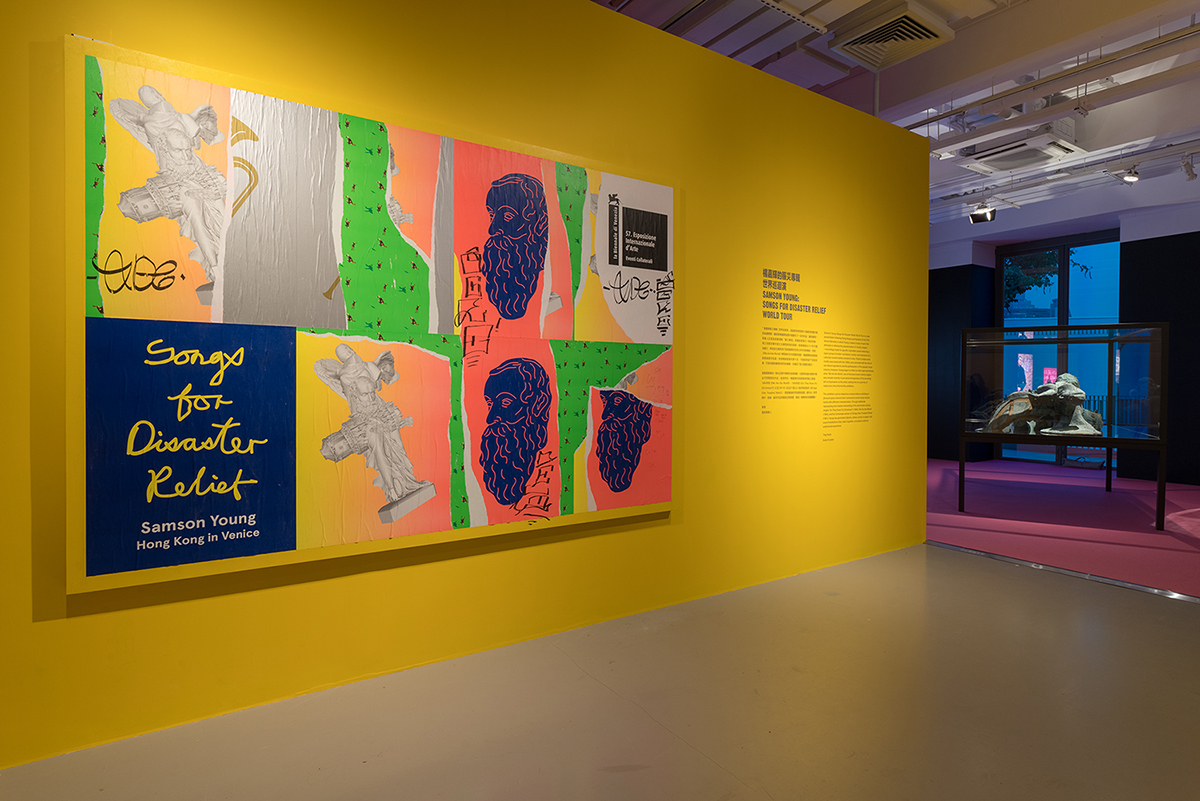Shows
“Songs for Disaster Relief World Tour”


Watching 2005’s Live 8 charity concerts on DVD and singing along to performances by my favorite musicians as a child remained, for a long time, an innocent memory. Later, I met others from around the world who fondly recalled being at Live 8 or even its predecessor, Live Aid, in 1985, revealing how indelibly these major events have marked a generation’s collective memory of recent musical history.
Only in retrospect was I able to see how problematic the charity shows and their politics were: from criticism over the lack of diversity in the lineup to the white-savior sentiments at the heart of its conception. In 2018, questions of representation and motive can no longer be isolated from the music itself.
Such context and critical engagement is what makes Samson Young’s “Songs for Disaster Relief World Tour”—which is, as the title suggests, inspired by benefit concerts—a timely and thought-provoking exhibition. Initially conceived for the 57th Venice Biennale, the project began after Young stumbled upon an article about a South African musician named Boomtown Gundane who had apparently written a song called “Yes We Do” in response to Band Aid’s “Do They Know It’s Christmas?” Young realized after some research that it was a satirical report—or, in his own words, “fake news”—but the seeds for his show were sown.
As one walked into the red-curtained foyer of the exhibition at West Kowloon’s M+ Pavilion, one felt the anticipation of heading into a opera, given Young's track record of merging music and visual arts to dramatic effect—after all, the artist is a musical composition graduate. What awaited was an experience that promised not only visual and auditory stimulation, but also a narrative arc presented in acts. Upon entering the foyer, viewers face a curious statue that melds together a smirking Ronald Reagan, a bust of Pythagoras, and a military bugle intersecting a space station—contextual clues that inform one’s understanding of the show. As the accompanying text to this work states, Reagan’s term as president of the United States was a driving force behind the rise of Western neoliberalism in the 1980s, an era suffused with the ideological belief that any problem could be solved through commerce, providing fertile ground for the proliferation of popular charity hits with the support of the mainstream music industry. Meanwhile, Greek philosopher Pythagoras is said to have given lessons to his students from behind a curtain, aiding their concentration by enabling them to experience sound without seeing the source; in the context of Young’s work, this reference seems to prompt viewers to reflect on how far a charity song can be taken at face value—as mere sound—and alienated from the motives of its performers. No obvious explanation has been provided for the space station: could it be a remnant of the space race, or a reference to the late singer David Bowie’s alien alter-ego, Ziggy Stardust?

In Palazzo Gundane (Homage to the Myth-maker who Fell to Earth) (2017), Young dedicates a room to his fictional protagonist Boomtown Gundane, in which lyrics from charity songs flash across a black curtain, while animations of a boy and a girl from the cover of “Do They Know It’s Christmas?” dancing erratically—almost desperately—for no discernible audience play on a television screen. A copy of Albert Camus’s The Myth of Sisyphus sits inconspicuously on a table in the corner, imbuing the scene with a sense of futility. In the next room, viewers see a video of the Hong Kong Federation of Trade Unions choir performing “We Are The World,” but rather than singing at normal volume, the choir delivers the music in loud, energetic whispers, as if, despite their best efforts, this muted sound is all they can manage. Both works question the effectiveness of charity singles and performances in achieving their lofty goals of alleviating poverty and “changing the world,” with music, as Live Aid proclaimed.
But while the critique at the heart of “World Tour” may be aimed at the international audiences of such charity shows, Young’s references are also local and personal. In the next room, which is stylized as a recording studio, a video shows the artist with his back turned to the viewer surrounded by water, singing numbers in place of lyrics to Simon & Garfunkel’s “Bridge Over Troubled Water” as a reference to the hotline and dollar amounts that would flash on the screen in televised calls for donations after natural disasters. A Cantonese version of this song was released in 1991 to raise money for flood relief efforts in China. Considering the strained relationship between Hong Kong and China today, the “troubled water” in the song seems to be an ominous reminder of current political tensions.

Outside the exhibition space is Risers (2017), a neon text installation that says, “The world is yours but also ours but basically yours.” Taken from the Quotations of Chairman Mao Tse-tung, the intended audience of the speech was young Chinese students in 1957, but Young does not appear to be directing the comment to any group in particular. Instead, he seems to be asking: if the voices of the marginalized continue to be suppressed and are not given a platform on the world stage, then to whom does the world really belong?
“Songs for Disaster Relief World Tour” is on view at M+ Pavilion, Hong Kong, until May 6, 2018.







